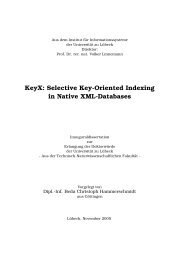Gesture-Based Interaction with Time-of-Flight Cameras
Gesture-Based Interaction with Time-of-Flight Cameras
Gesture-Based Interaction with Time-of-Flight Cameras
Create successful ePaper yourself
Turn your PDF publications into a flip-book with our unique Google optimized e-Paper software.
3<br />
Introduction<br />
The second part <strong>of</strong> this thesis is devoted to computer vision algorithms designed for<br />
TOF camera data. In this context, we will demonstrate the advantage <strong>of</strong> a combined<br />
image sensor that delivers both range and intensity, i.e. we will explicitly show how<br />
the combination <strong>of</strong> both types <strong>of</strong> data significantly improves the performance <strong>of</strong> al-<br />
gorithms in contrast to using either data alone. The first section <strong>of</strong> this chapter will<br />
focus on the improvement <strong>of</strong> the range measurement by exploiting the intensity im-<br />
age under the well-defined lighting conditions provided by the TOF camera illumi-<br />
nation. Secondly, we will address the topic <strong>of</strong> image segmentation. Here, the goal<br />
is to identify connected image regions that depict an object or a person present in<br />
the scene. These results will then be used in an algorithm for the estimation <strong>of</strong> hu-<br />
man pose that fits a simple model <strong>of</strong> the human body in 3D. Finally, we will turn<br />
to the discussion <strong>of</strong> suitable image features for encoding relevant properties <strong>of</strong> TOF<br />
images. In this context, we will first discuss geometrically motivated features that<br />
are related to the Gaussian curvature. We will then reformulate the computation <strong>of</strong><br />
these features in 3D to achieve scale invariance. A third type <strong>of</strong> features is obtained<br />
using the sparse coding principle. These three types <strong>of</strong> features will be evaluated in<br />
the context <strong>of</strong> detecting facial features, such as the nose. Finally, we will turn to the<br />
computation <strong>of</strong> range flow and will use the resulting 3D motion vectors for the recog-<br />
nition <strong>of</strong> human gestures. In the following, we will give a brief overview <strong>of</strong> the four<br />
topics discussed in the scope <strong>of</strong> Part II <strong>of</strong> thesis <strong>with</strong>in Chapter 4 through Chapter 7.<br />
Shading Constraint Improves TOF Measurements<br />
In Chapter 4, we describe a technique for improving the accuracy <strong>of</strong> range maps mea-<br />
sured by a TOF camera. Our technique is based on the observation that the range<br />
map and intensity image are not independent but are linked by the shading con-<br />
29

















